Perceived Cost, Value, and Consumer Purchase Intentions Analysis
VerifiedAdded on 2021/06/30
|28
|7586
|279
Report
AI Summary
This report investigates the relationship between perceived price, perceived value, and consumer purchase intentions within Pakistan's beverage industry. The study employs a quantitative research design, utilizing questionnaires to gather data from 300 respondents across universities and markets in Rawalpindi. The research examines the impact of brand image, the relationship between overall perceived price and perceived value, and the connection between consumer purchase intention and overall perceived value. Statistical analyses, including simple linear regression, are used to test two key hypotheses: that there is a significant relationship between perceived relative price and perceived value, and that there is a significant relationship between overall perceived value and consumers' overall purchase intention. The findings suggest that price significantly influences consumer purchase intentions. The report also provides a literature review, research methodology, results and interpretation, conclusions, and recommendations for the beverage industry in Pakistan.
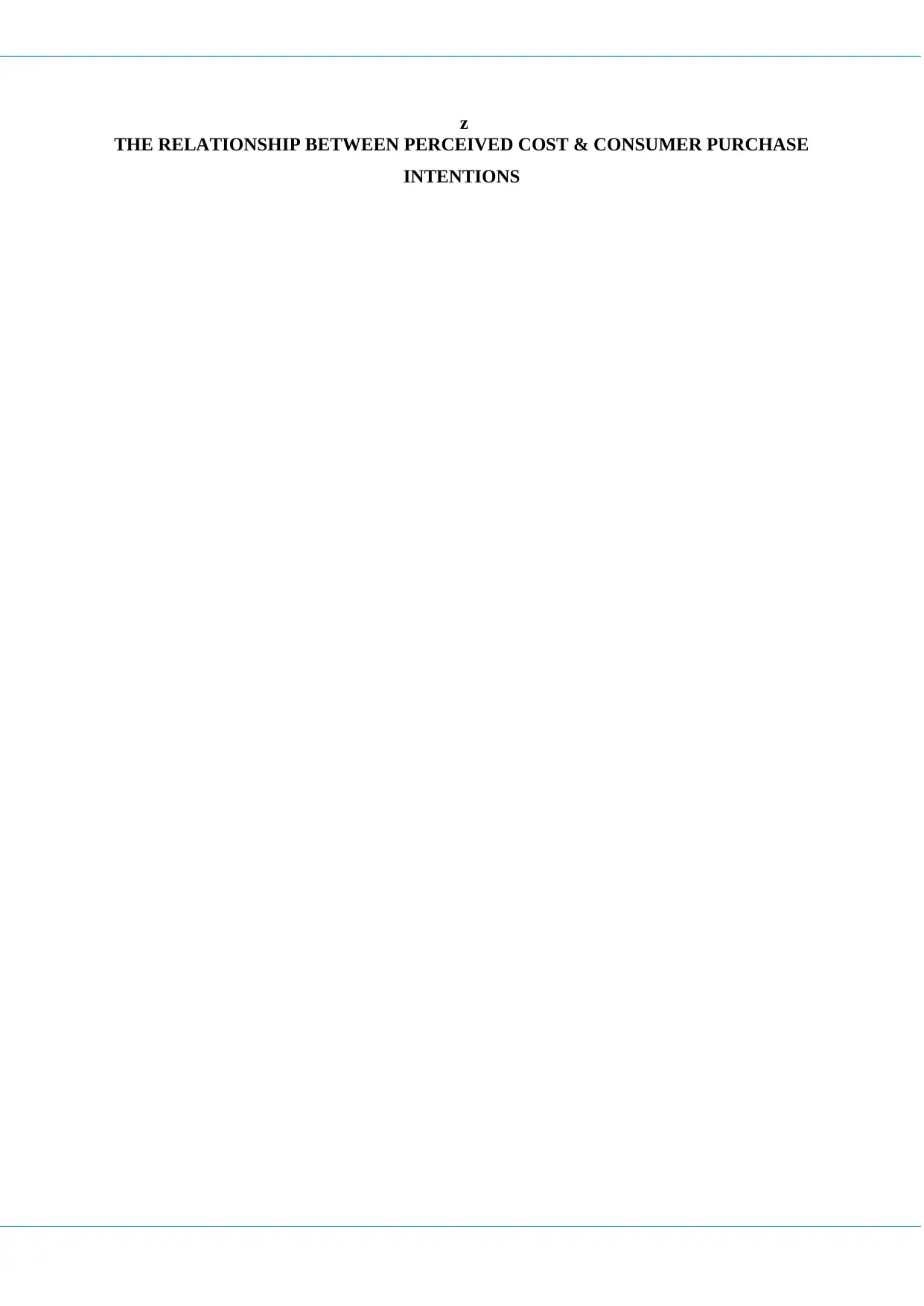
z
THE RELATIONSHIP BETWEEN PERCEIVED COST & CONSUMER PURCHASE
INTENTIONS
THE RELATIONSHIP BETWEEN PERCEIVED COST & CONSUMER PURCHASE
INTENTIONS
Paraphrase This Document
Need a fresh take? Get an instant paraphrase of this document with our AI Paraphraser
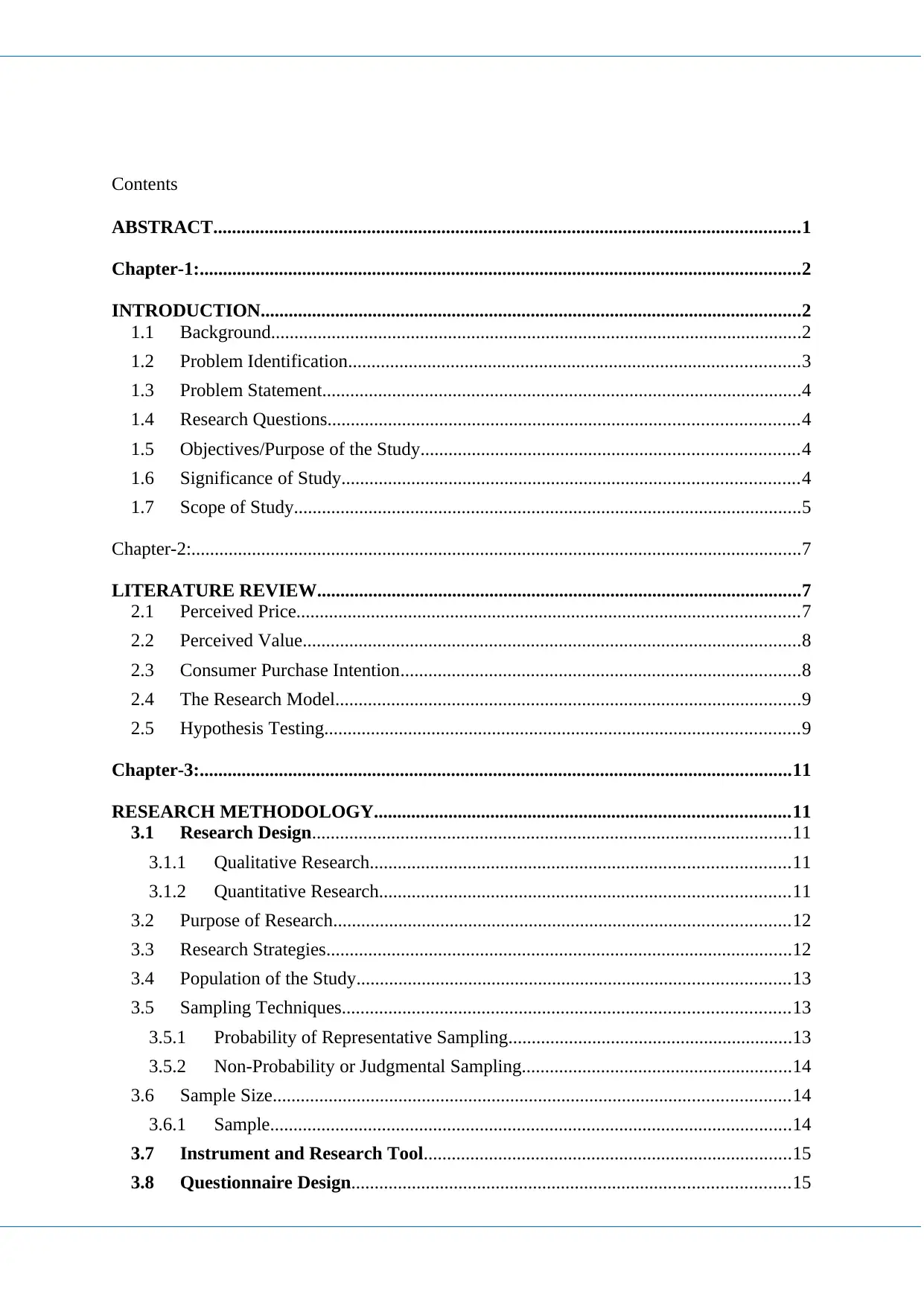
Contents
ABSTRACT..............................................................................................................................1
Chapter-1:.................................................................................................................................2
INTRODUCTION....................................................................................................................2
1.1 Background..................................................................................................................2
1.2 Problem Identification.................................................................................................3
1.3 Problem Statement.......................................................................................................4
1.4 Research Questions.....................................................................................................4
1.5 Objectives/Purpose of the Study.................................................................................4
1.6 Significance of Study..................................................................................................4
1.7 Scope of Study.............................................................................................................5
Chapter-2:...................................................................................................................................7
LITERATURE REVIEW........................................................................................................7
2.1 Perceived Price............................................................................................................7
2.2 Perceived Value...........................................................................................................8
2.3 Consumer Purchase Intention......................................................................................8
2.4 The Research Model....................................................................................................9
2.5 Hypothesis Testing......................................................................................................9
Chapter-3:...............................................................................................................................11
RESEARCH METHODOLOGY.........................................................................................11
3.1 Research Design.......................................................................................................11
3.1.1 Qualitative Research..........................................................................................11
3.1.2 Quantitative Research........................................................................................11
3.2 Purpose of Research..................................................................................................12
3.3 Research Strategies....................................................................................................12
3.4 Population of the Study.............................................................................................13
3.5 Sampling Techniques................................................................................................13
3.5.1 Probability of Representative Sampling.............................................................13
3.5.2 Non-Probability or Judgmental Sampling..........................................................14
3.6 Sample Size...............................................................................................................14
3.6.1 Sample................................................................................................................14
3.7 Instrument and Research Tool...............................................................................15
3.8 Questionnaire Design..............................................................................................15
ABSTRACT..............................................................................................................................1
Chapter-1:.................................................................................................................................2
INTRODUCTION....................................................................................................................2
1.1 Background..................................................................................................................2
1.2 Problem Identification.................................................................................................3
1.3 Problem Statement.......................................................................................................4
1.4 Research Questions.....................................................................................................4
1.5 Objectives/Purpose of the Study.................................................................................4
1.6 Significance of Study..................................................................................................4
1.7 Scope of Study.............................................................................................................5
Chapter-2:...................................................................................................................................7
LITERATURE REVIEW........................................................................................................7
2.1 Perceived Price............................................................................................................7
2.2 Perceived Value...........................................................................................................8
2.3 Consumer Purchase Intention......................................................................................8
2.4 The Research Model....................................................................................................9
2.5 Hypothesis Testing......................................................................................................9
Chapter-3:...............................................................................................................................11
RESEARCH METHODOLOGY.........................................................................................11
3.1 Research Design.......................................................................................................11
3.1.1 Qualitative Research..........................................................................................11
3.1.2 Quantitative Research........................................................................................11
3.2 Purpose of Research..................................................................................................12
3.3 Research Strategies....................................................................................................12
3.4 Population of the Study.............................................................................................13
3.5 Sampling Techniques................................................................................................13
3.5.1 Probability of Representative Sampling.............................................................13
3.5.2 Non-Probability or Judgmental Sampling..........................................................14
3.6 Sample Size...............................................................................................................14
3.6.1 Sample................................................................................................................14
3.7 Instrument and Research Tool...............................................................................15
3.8 Questionnaire Design..............................................................................................15
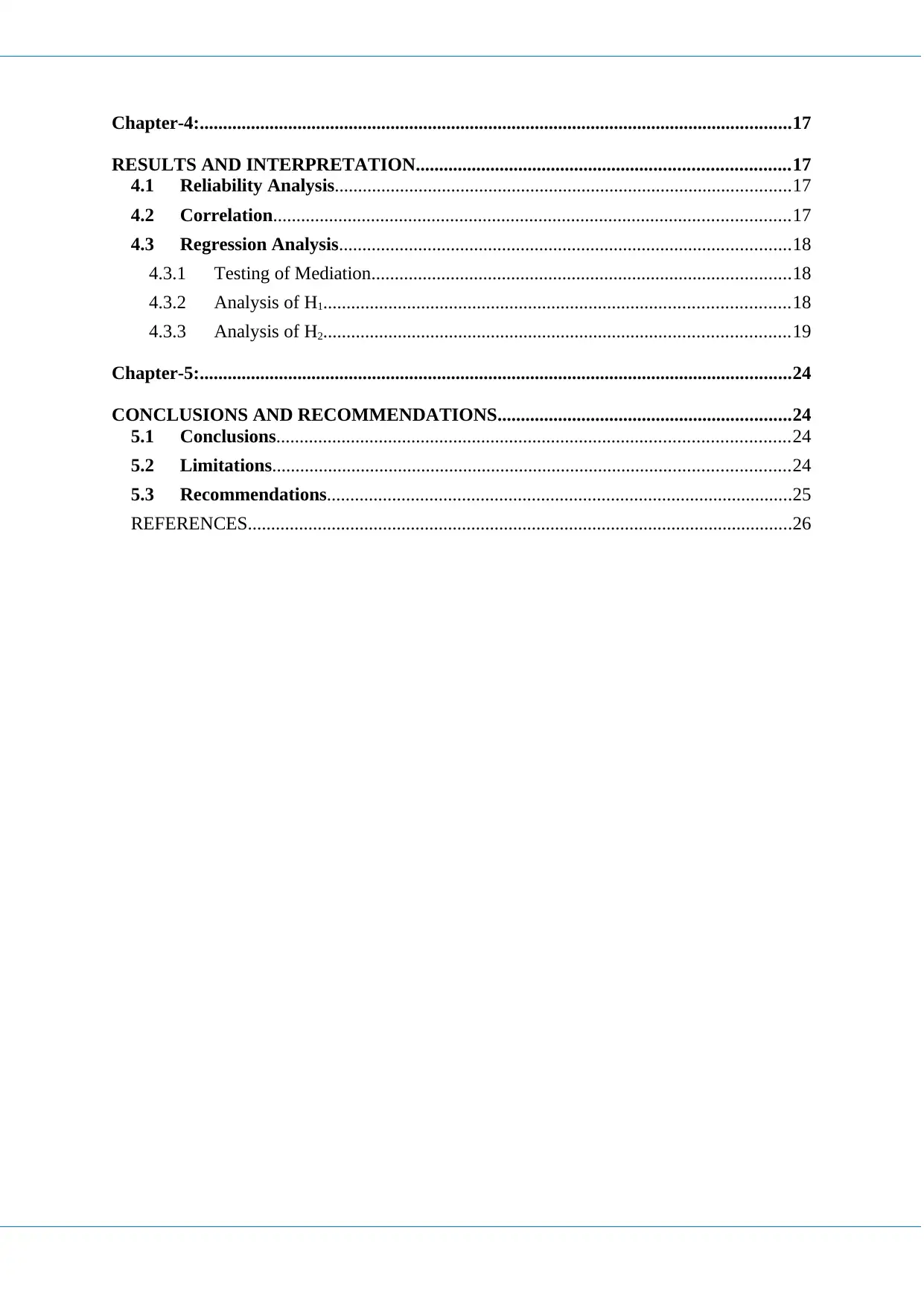
Chapter-4:...............................................................................................................................17
RESULTS AND INTERPRETATION................................................................................17
4.1 Reliability Analysis..................................................................................................17
4.2 Correlation...............................................................................................................17
4.3 Regression Analysis.................................................................................................18
4.3.1 Testing of Mediation..........................................................................................18
4.3.2 Analysis of H1....................................................................................................18
4.3.3 Analysis of H2....................................................................................................19
Chapter-5:...............................................................................................................................24
CONCLUSIONS AND RECOMMENDATIONS...............................................................24
5.1 Conclusions..............................................................................................................24
5.2 Limitations...............................................................................................................24
5.3 Recommendations....................................................................................................25
REFERENCES.....................................................................................................................26
RESULTS AND INTERPRETATION................................................................................17
4.1 Reliability Analysis..................................................................................................17
4.2 Correlation...............................................................................................................17
4.3 Regression Analysis.................................................................................................18
4.3.1 Testing of Mediation..........................................................................................18
4.3.2 Analysis of H1....................................................................................................18
4.3.3 Analysis of H2....................................................................................................19
Chapter-5:...............................................................................................................................24
CONCLUSIONS AND RECOMMENDATIONS...............................................................24
5.1 Conclusions..............................................................................................................24
5.2 Limitations...............................................................................................................24
5.3 Recommendations....................................................................................................25
REFERENCES.....................................................................................................................26
⊘ This is a preview!⊘
Do you want full access?
Subscribe today to unlock all pages.

Trusted by 1+ million students worldwide
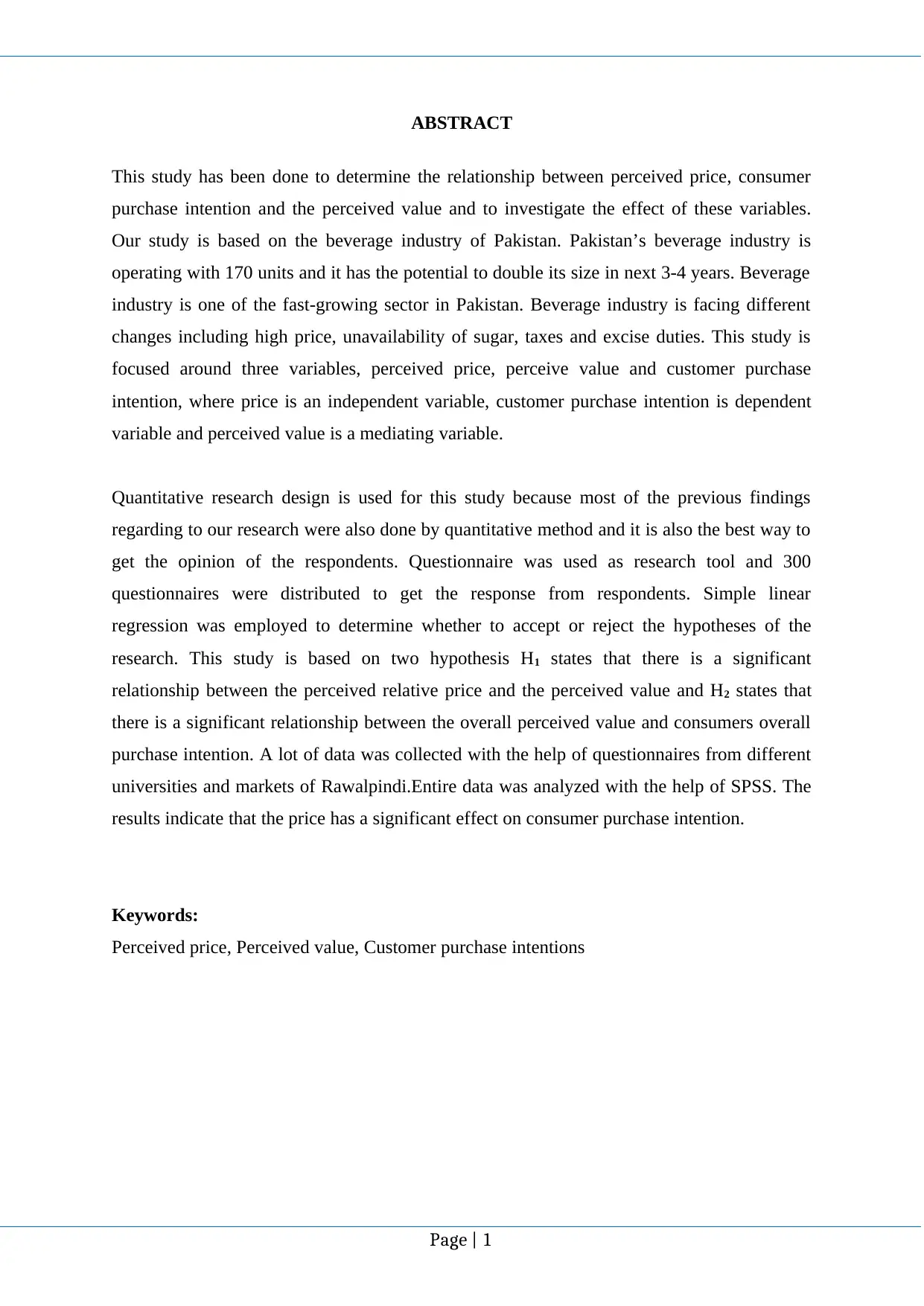
ABSTRACT
This study has been done to determine the relationship between perceived price, consumer
purchase intention and the perceived value and to investigate the effect of these variables.
Our study is based on the beverage industry of Pakistan. Pakistan’s beverage industry is
operating with 170 units and it has the potential to double its size in next 3-4 years. Beverage
industry is one of the fast-growing sector in Pakistan. Beverage industry is facing different
changes including high price, unavailability of sugar, taxes and excise duties. This study is
focused around three variables, perceived price, perceive value and customer purchase
intention, where price is an independent variable, customer purchase intention is dependent
variable and perceived value is a mediating variable.
Quantitative research design is used for this study because most of the previous findings
regarding to our research were also done by quantitative method and it is also the best way to
get the opinion of the respondents. Questionnaire was used as research tool and 300
questionnaires were distributed to get the response from respondents. Simple linear
regression was employed to determine whether to accept or reject the hypotheses of the
research. This study is based on two hypothesis H1 states that there is a significant
relationship between the perceived relative price and the perceived value and H2 states that
there is a significant relationship between the overall perceived value and consumers overall
purchase intention. A lot of data was collected with the help of questionnaires from different
universities and markets of Rawalpindi.Entire data was analyzed with the help of SPSS. The
results indicate that the price has a significant effect on consumer purchase intention.
Keywords:
Perceived price, Perceived value, Customer purchase intentions
Page | 1
This study has been done to determine the relationship between perceived price, consumer
purchase intention and the perceived value and to investigate the effect of these variables.
Our study is based on the beverage industry of Pakistan. Pakistan’s beverage industry is
operating with 170 units and it has the potential to double its size in next 3-4 years. Beverage
industry is one of the fast-growing sector in Pakistan. Beverage industry is facing different
changes including high price, unavailability of sugar, taxes and excise duties. This study is
focused around three variables, perceived price, perceive value and customer purchase
intention, where price is an independent variable, customer purchase intention is dependent
variable and perceived value is a mediating variable.
Quantitative research design is used for this study because most of the previous findings
regarding to our research were also done by quantitative method and it is also the best way to
get the opinion of the respondents. Questionnaire was used as research tool and 300
questionnaires were distributed to get the response from respondents. Simple linear
regression was employed to determine whether to accept or reject the hypotheses of the
research. This study is based on two hypothesis H1 states that there is a significant
relationship between the perceived relative price and the perceived value and H2 states that
there is a significant relationship between the overall perceived value and consumers overall
purchase intention. A lot of data was collected with the help of questionnaires from different
universities and markets of Rawalpindi.Entire data was analyzed with the help of SPSS. The
results indicate that the price has a significant effect on consumer purchase intention.
Keywords:
Perceived price, Perceived value, Customer purchase intentions
Page | 1
Paraphrase This Document
Need a fresh take? Get an instant paraphrase of this document with our AI Paraphraser
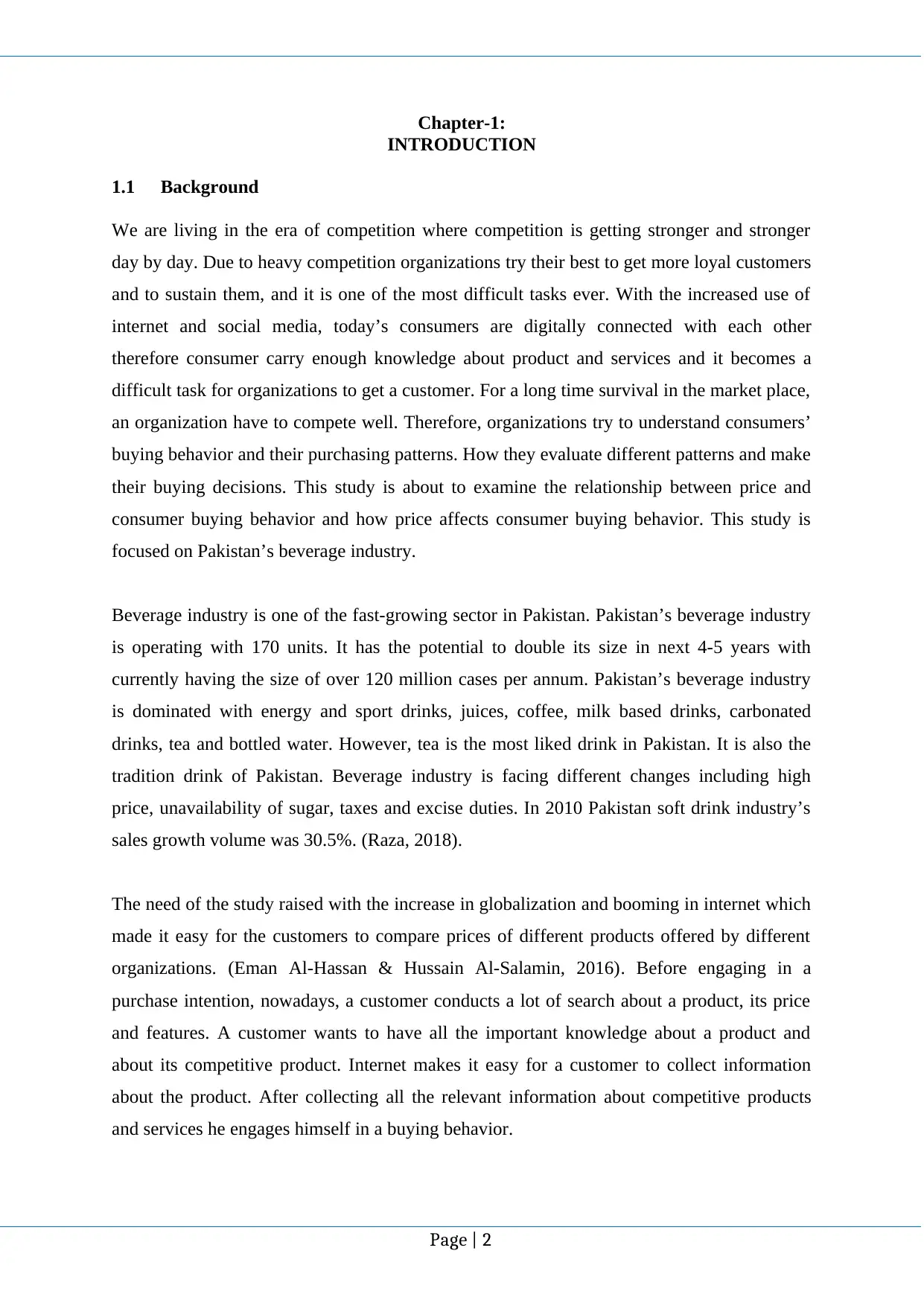
Chapter-1:
INTRODUCTION
1.1 Background
We are living in the era of competition where competition is getting stronger and stronger
day by day. Due to heavy competition organizations try their best to get more loyal customers
and to sustain them, and it is one of the most difficult tasks ever. With the increased use of
internet and social media, today’s consumers are digitally connected with each other
therefore consumer carry enough knowledge about product and services and it becomes a
difficult task for organizations to get a customer. For a long time survival in the market place,
an organization have to compete well. Therefore, organizations try to understand consumers’
buying behavior and their purchasing patterns. How they evaluate different patterns and make
their buying decisions. This study is about to examine the relationship between price and
consumer buying behavior and how price affects consumer buying behavior. This study is
focused on Pakistan’s beverage industry.
Beverage industry is one of the fast-growing sector in Pakistan. Pakistan’s beverage industry
is operating with 170 units. It has the potential to double its size in next 4-5 years with
currently having the size of over 120 million cases per annum. Pakistan’s beverage industry
is dominated with energy and sport drinks, juices, coffee, milk based drinks, carbonated
drinks, tea and bottled water. However, tea is the most liked drink in Pakistan. It is also the
tradition drink of Pakistan. Beverage industry is facing different changes including high
price, unavailability of sugar, taxes and excise duties. In 2010 Pakistan soft drink industry’s
sales growth volume was 30.5%. (Raza, 2018).
The need of the study raised with the increase in globalization and booming in internet which
made it easy for the customers to compare prices of different products offered by different
organizations. (Eman Al-Hassan & Hussain Al-Salamin, 2016). Before engaging in a
purchase intention, nowadays, a customer conducts a lot of search about a product, its price
and features. A customer wants to have all the important knowledge about a product and
about its competitive product. Internet makes it easy for a customer to collect information
about the product. After collecting all the relevant information about competitive products
and services he engages himself in a buying behavior.
Page | 2
INTRODUCTION
1.1 Background
We are living in the era of competition where competition is getting stronger and stronger
day by day. Due to heavy competition organizations try their best to get more loyal customers
and to sustain them, and it is one of the most difficult tasks ever. With the increased use of
internet and social media, today’s consumers are digitally connected with each other
therefore consumer carry enough knowledge about product and services and it becomes a
difficult task for organizations to get a customer. For a long time survival in the market place,
an organization have to compete well. Therefore, organizations try to understand consumers’
buying behavior and their purchasing patterns. How they evaluate different patterns and make
their buying decisions. This study is about to examine the relationship between price and
consumer buying behavior and how price affects consumer buying behavior. This study is
focused on Pakistan’s beverage industry.
Beverage industry is one of the fast-growing sector in Pakistan. Pakistan’s beverage industry
is operating with 170 units. It has the potential to double its size in next 4-5 years with
currently having the size of over 120 million cases per annum. Pakistan’s beverage industry
is dominated with energy and sport drinks, juices, coffee, milk based drinks, carbonated
drinks, tea and bottled water. However, tea is the most liked drink in Pakistan. It is also the
tradition drink of Pakistan. Beverage industry is facing different changes including high
price, unavailability of sugar, taxes and excise duties. In 2010 Pakistan soft drink industry’s
sales growth volume was 30.5%. (Raza, 2018).
The need of the study raised with the increase in globalization and booming in internet which
made it easy for the customers to compare prices of different products offered by different
organizations. (Eman Al-Hassan & Hussain Al-Salamin, 2016). Before engaging in a
purchase intention, nowadays, a customer conducts a lot of search about a product, its price
and features. A customer wants to have all the important knowledge about a product and
about its competitive product. Internet makes it easy for a customer to collect information
about the product. After collecting all the relevant information about competitive products
and services he engages himself in a buying behavior.
Page | 2
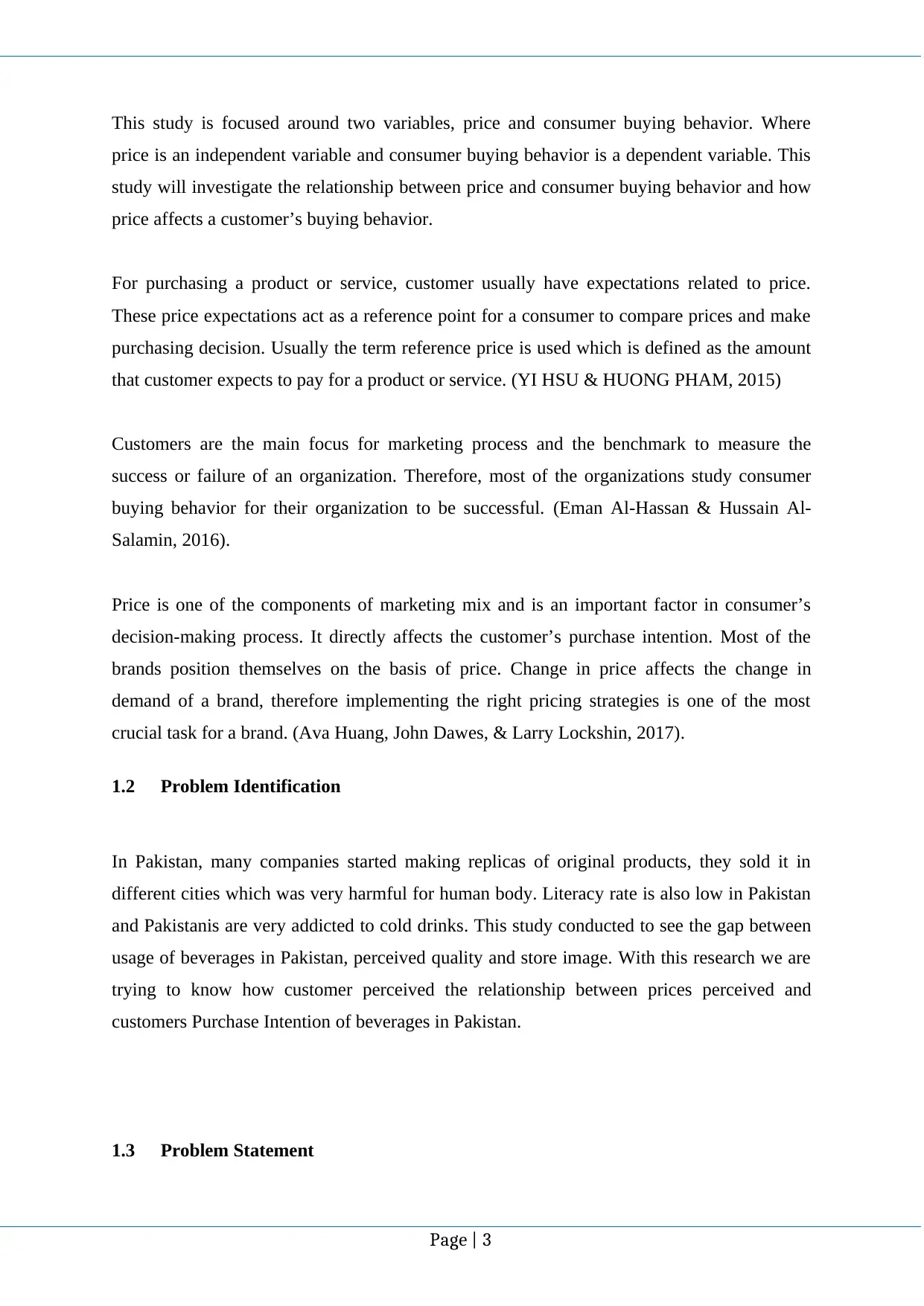
This study is focused around two variables, price and consumer buying behavior. Where
price is an independent variable and consumer buying behavior is a dependent variable. This
study will investigate the relationship between price and consumer buying behavior and how
price affects a customer’s buying behavior.
For purchasing a product or service, customer usually have expectations related to price.
These price expectations act as a reference point for a consumer to compare prices and make
purchasing decision. Usually the term reference price is used which is defined as the amount
that customer expects to pay for a product or service. (YI HSU & HUONG PHAM, 2015)
Customers are the main focus for marketing process and the benchmark to measure the
success or failure of an organization. Therefore, most of the organizations study consumer
buying behavior for their organization to be successful. (Eman Al-Hassan & Hussain Al-
Salamin, 2016).
Price is one of the components of marketing mix and is an important factor in consumer’s
decision-making process. It directly affects the customer’s purchase intention. Most of the
brands position themselves on the basis of price. Change in price affects the change in
demand of a brand, therefore implementing the right pricing strategies is one of the most
crucial task for a brand. (Ava Huang, John Dawes, & Larry Lockshin, 2017).
1.2 Problem Identification
In Pakistan, many companies started making replicas of original products, they sold it in
different cities which was very harmful for human body. Literacy rate is also low in Pakistan
and Pakistanis are very addicted to cold drinks. This study conducted to see the gap between
usage of beverages in Pakistan, perceived quality and store image. With this research we are
trying to know how customer perceived the relationship between prices perceived and
customers Purchase Intention of beverages in Pakistan.
1.3 Problem Statement
Page | 3
price is an independent variable and consumer buying behavior is a dependent variable. This
study will investigate the relationship between price and consumer buying behavior and how
price affects a customer’s buying behavior.
For purchasing a product or service, customer usually have expectations related to price.
These price expectations act as a reference point for a consumer to compare prices and make
purchasing decision. Usually the term reference price is used which is defined as the amount
that customer expects to pay for a product or service. (YI HSU & HUONG PHAM, 2015)
Customers are the main focus for marketing process and the benchmark to measure the
success or failure of an organization. Therefore, most of the organizations study consumer
buying behavior for their organization to be successful. (Eman Al-Hassan & Hussain Al-
Salamin, 2016).
Price is one of the components of marketing mix and is an important factor in consumer’s
decision-making process. It directly affects the customer’s purchase intention. Most of the
brands position themselves on the basis of price. Change in price affects the change in
demand of a brand, therefore implementing the right pricing strategies is one of the most
crucial task for a brand. (Ava Huang, John Dawes, & Larry Lockshin, 2017).
1.2 Problem Identification
In Pakistan, many companies started making replicas of original products, they sold it in
different cities which was very harmful for human body. Literacy rate is also low in Pakistan
and Pakistanis are very addicted to cold drinks. This study conducted to see the gap between
usage of beverages in Pakistan, perceived quality and store image. With this research we are
trying to know how customer perceived the relationship between prices perceived and
customers Purchase Intention of beverages in Pakistan.
1.3 Problem Statement
Page | 3
⊘ This is a preview!⊘
Do you want full access?
Subscribe today to unlock all pages.

Trusted by 1+ million students worldwide
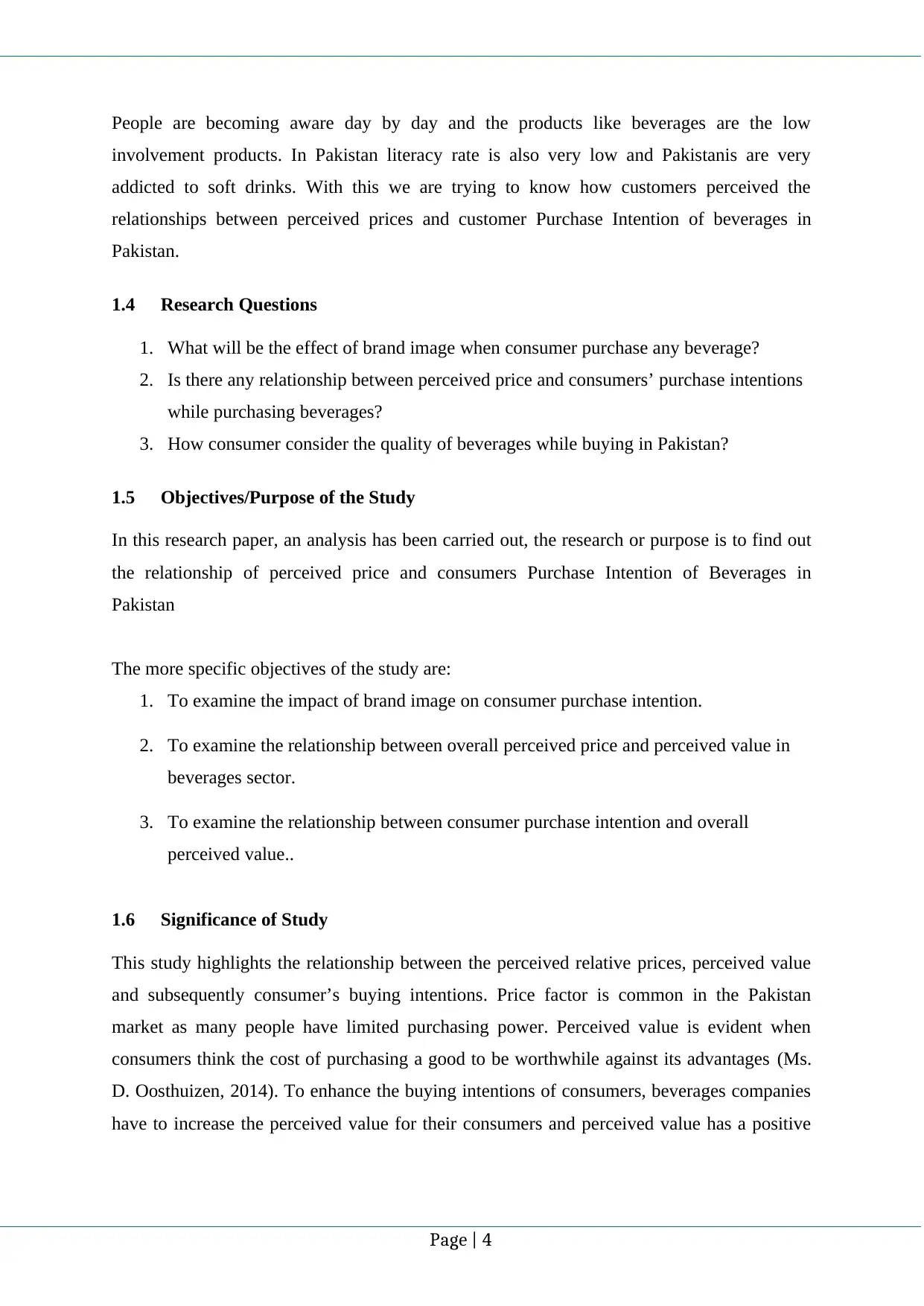
People are becoming aware day by day and the products like beverages are the low
involvement products. In Pakistan literacy rate is also very low and Pakistanis are very
addicted to soft drinks. With this we are trying to know how customers perceived the
relationships between perceived prices and customer Purchase Intention of beverages in
Pakistan.
1.4 Research Questions
1. What will be the effect of brand image when consumer purchase any beverage?
2. Is there any relationship between perceived price and consumers’ purchase intentions
while purchasing beverages?
3. How consumer consider the quality of beverages while buying in Pakistan?
1.5 Objectives/Purpose of the Study
In this research paper, an analysis has been carried out, the research or purpose is to find out
the relationship of perceived price and consumers Purchase Intention of Beverages in
Pakistan
The more specific objectives of the study are:
1. To examine the impact of brand image on consumer purchase intention.
2. To examine the relationship between overall perceived price and perceived value in
beverages sector.
3. To examine the relationship between consumer purchase intention and overall
perceived value..
1.6 Significance of Study
This study highlights the relationship between the perceived relative prices, perceived value
and subsequently consumer’s buying intentions. Price factor is common in the Pakistan
market as many people have limited purchasing power. Perceived value is evident when
consumers think the cost of purchasing a good to be worthwhile against its advantages (Ms.
D. Oosthuizen, 2014). To enhance the buying intentions of consumers, beverages companies
have to increase the perceived value for their consumers and perceived value has a positive
Page | 4
involvement products. In Pakistan literacy rate is also very low and Pakistanis are very
addicted to soft drinks. With this we are trying to know how customers perceived the
relationships between perceived prices and customer Purchase Intention of beverages in
Pakistan.
1.4 Research Questions
1. What will be the effect of brand image when consumer purchase any beverage?
2. Is there any relationship between perceived price and consumers’ purchase intentions
while purchasing beverages?
3. How consumer consider the quality of beverages while buying in Pakistan?
1.5 Objectives/Purpose of the Study
In this research paper, an analysis has been carried out, the research or purpose is to find out
the relationship of perceived price and consumers Purchase Intention of Beverages in
Pakistan
The more specific objectives of the study are:
1. To examine the impact of brand image on consumer purchase intention.
2. To examine the relationship between overall perceived price and perceived value in
beverages sector.
3. To examine the relationship between consumer purchase intention and overall
perceived value..
1.6 Significance of Study
This study highlights the relationship between the perceived relative prices, perceived value
and subsequently consumer’s buying intentions. Price factor is common in the Pakistan
market as many people have limited purchasing power. Perceived value is evident when
consumers think the cost of purchasing a good to be worthwhile against its advantages (Ms.
D. Oosthuizen, 2014). To enhance the buying intentions of consumers, beverages companies
have to increase the perceived value for their consumers and perceived value has a positive
Page | 4
Paraphrase This Document
Need a fresh take? Get an instant paraphrase of this document with our AI Paraphraser
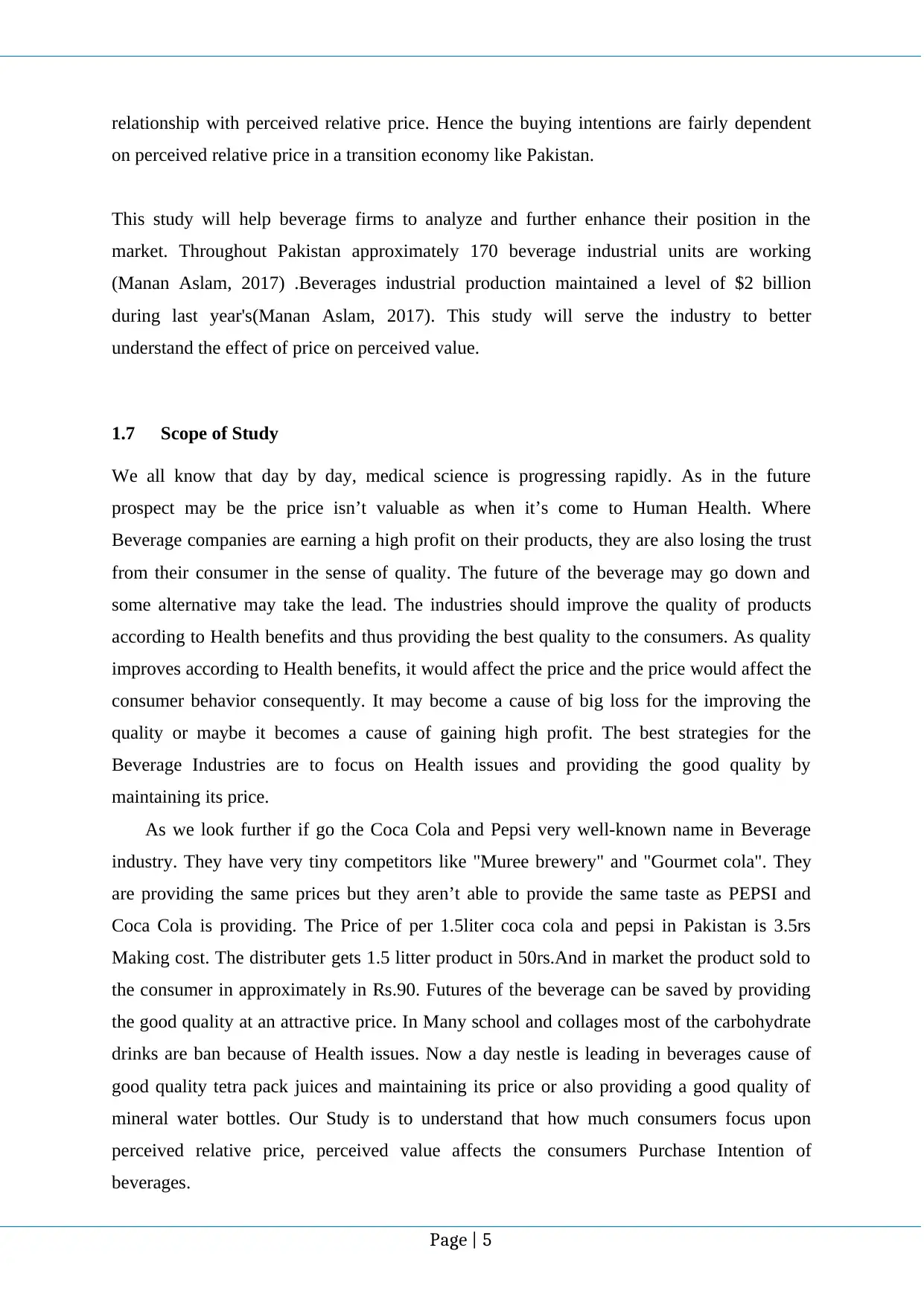
relationship with perceived relative price. Hence the buying intentions are fairly dependent
on perceived relative price in a transition economy like Pakistan.
This study will help beverage firms to analyze and further enhance their position in the
market. Throughout Pakistan approximately 170 beverage industrial units are working
(Manan Aslam, 2017) .Beverages industrial production maintained a level of $2 billion
during last year's(Manan Aslam, 2017). This study will serve the industry to better
understand the effect of price on perceived value.
1.7 Scope of Study
We all know that day by day, medical science is progressing rapidly. As in the future
prospect may be the price isn’t valuable as when it’s come to Human Health. Where
Beverage companies are earning a high profit on their products, they are also losing the trust
from their consumer in the sense of quality. The future of the beverage may go down and
some alternative may take the lead. The industries should improve the quality of products
according to Health benefits and thus providing the best quality to the consumers. As quality
improves according to Health benefits, it would affect the price and the price would affect the
consumer behavior consequently. It may become a cause of big loss for the improving the
quality or maybe it becomes a cause of gaining high profit. The best strategies for the
Beverage Industries are to focus on Health issues and providing the good quality by
maintaining its price.
As we look further if go the Coca Cola and Pepsi very well-known name in Beverage
industry. They have very tiny competitors like "Muree brewery" and "Gourmet cola". They
are providing the same prices but they aren’t able to provide the same taste as PEPSI and
Coca Cola is providing. The Price of per 1.5liter coca cola and pepsi in Pakistan is 3.5rs
Making cost. The distributer gets 1.5 litter product in 50rs.And in market the product sold to
the consumer in approximately in Rs.90. Futures of the beverage can be saved by providing
the good quality at an attractive price. In Many school and collages most of the carbohydrate
drinks are ban because of Health issues. Now a day nestle is leading in beverages cause of
good quality tetra pack juices and maintaining its price or also providing a good quality of
mineral water bottles. Our Study is to understand that how much consumers focus upon
perceived relative price, perceived value affects the consumers Purchase Intention of
beverages.
Page | 5
on perceived relative price in a transition economy like Pakistan.
This study will help beverage firms to analyze and further enhance their position in the
market. Throughout Pakistan approximately 170 beverage industrial units are working
(Manan Aslam, 2017) .Beverages industrial production maintained a level of $2 billion
during last year's(Manan Aslam, 2017). This study will serve the industry to better
understand the effect of price on perceived value.
1.7 Scope of Study
We all know that day by day, medical science is progressing rapidly. As in the future
prospect may be the price isn’t valuable as when it’s come to Human Health. Where
Beverage companies are earning a high profit on their products, they are also losing the trust
from their consumer in the sense of quality. The future of the beverage may go down and
some alternative may take the lead. The industries should improve the quality of products
according to Health benefits and thus providing the best quality to the consumers. As quality
improves according to Health benefits, it would affect the price and the price would affect the
consumer behavior consequently. It may become a cause of big loss for the improving the
quality or maybe it becomes a cause of gaining high profit. The best strategies for the
Beverage Industries are to focus on Health issues and providing the good quality by
maintaining its price.
As we look further if go the Coca Cola and Pepsi very well-known name in Beverage
industry. They have very tiny competitors like "Muree brewery" and "Gourmet cola". They
are providing the same prices but they aren’t able to provide the same taste as PEPSI and
Coca Cola is providing. The Price of per 1.5liter coca cola and pepsi in Pakistan is 3.5rs
Making cost. The distributer gets 1.5 litter product in 50rs.And in market the product sold to
the consumer in approximately in Rs.90. Futures of the beverage can be saved by providing
the good quality at an attractive price. In Many school and collages most of the carbohydrate
drinks are ban because of Health issues. Now a day nestle is leading in beverages cause of
good quality tetra pack juices and maintaining its price or also providing a good quality of
mineral water bottles. Our Study is to understand that how much consumers focus upon
perceived relative price, perceived value affects the consumers Purchase Intention of
beverages.
Page | 5
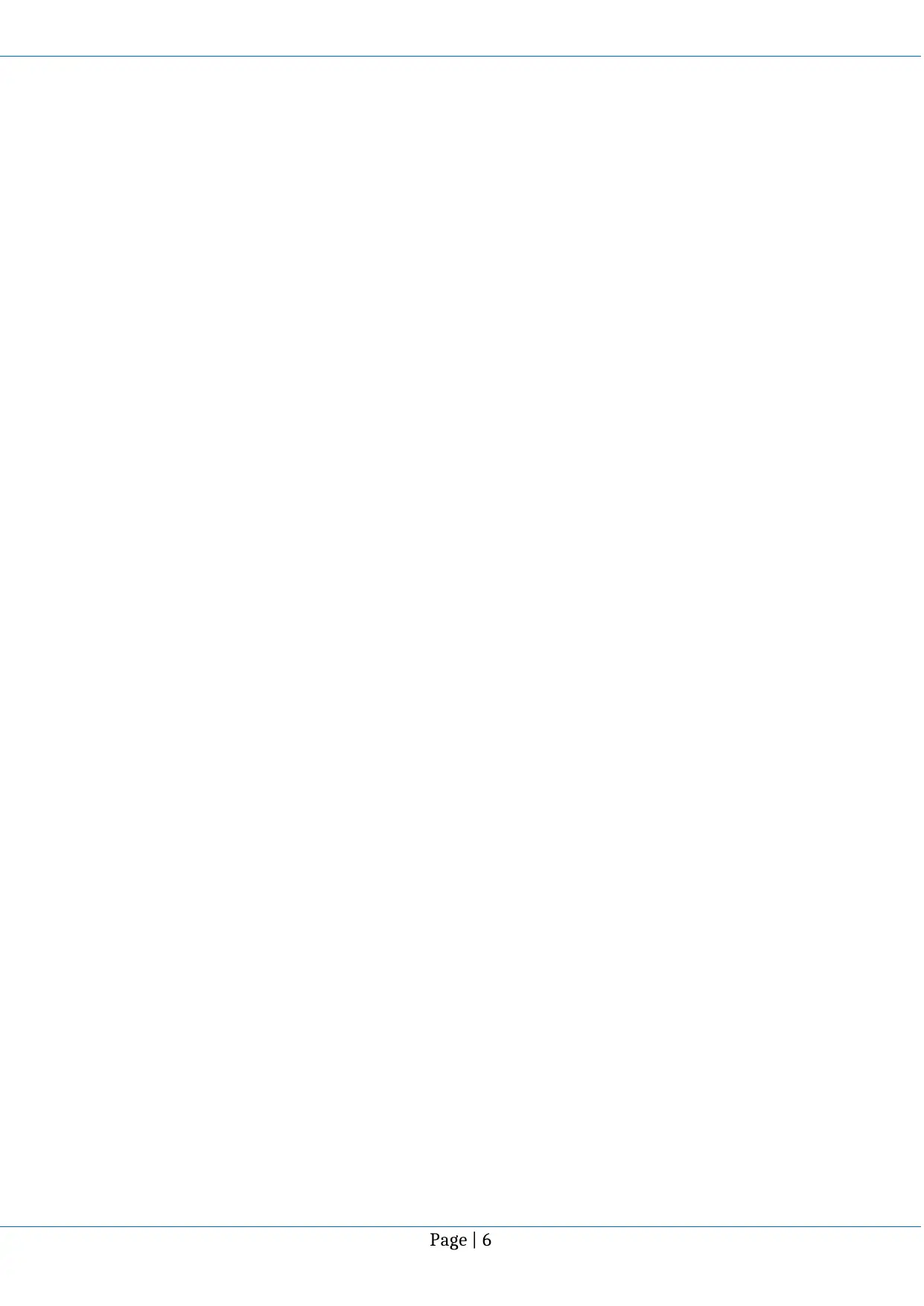
Page | 6
⊘ This is a preview!⊘
Do you want full access?
Subscribe today to unlock all pages.

Trusted by 1+ million students worldwide
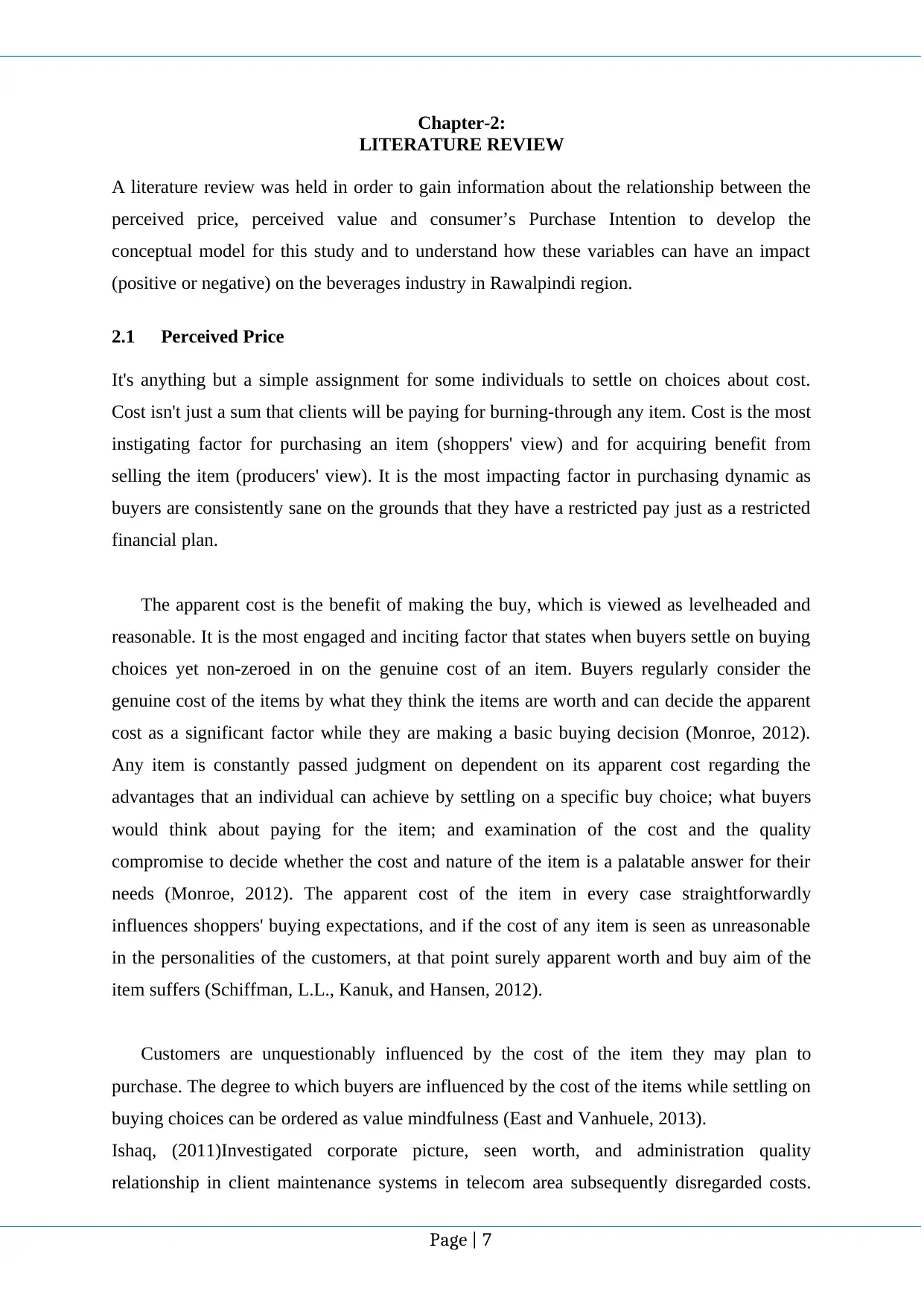
Chapter-2:
LITERATURE REVIEW
A literature review was held in order to gain information about the relationship between the
perceived price, perceived value and consumer’s Purchase Intention to develop the
conceptual model for this study and to understand how these variables can have an impact
(positive or negative) on the beverages industry in Rawalpindi region.
2.1 Perceived Price
It's anything but a simple assignment for some individuals to settle on choices about cost.
Cost isn't just a sum that clients will be paying for burning-through any item. Cost is the most
instigating factor for purchasing an item (shoppers' view) and for acquiring benefit from
selling the item (producers' view). It is the most impacting factor in purchasing dynamic as
buyers are consistently sane on the grounds that they have a restricted pay just as a restricted
financial plan.
The apparent cost is the benefit of making the buy, which is viewed as levelheaded and
reasonable. It is the most engaged and inciting factor that states when buyers settle on buying
choices yet non-zeroed in on the genuine cost of an item. Buyers regularly consider the
genuine cost of the items by what they think the items are worth and can decide the apparent
cost as a significant factor while they are making a basic buying decision (Monroe, 2012).
Any item is constantly passed judgment on dependent on its apparent cost regarding the
advantages that an individual can achieve by settling on a specific buy choice; what buyers
would think about paying for the item; and examination of the cost and the quality
compromise to decide whether the cost and nature of the item is a palatable answer for their
needs (Monroe, 2012). The apparent cost of the item in every case straightforwardly
influences shoppers' buying expectations, and if the cost of any item is seen as unreasonable
in the personalities of the customers, at that point surely apparent worth and buy aim of the
item suffers (Schiffman, L.L., Kanuk, and Hansen, 2012).
Customers are unquestionably influenced by the cost of the item they may plan to
purchase. The degree to which buyers are influenced by the cost of the items while settling on
buying choices can be ordered as value mindfulness (East and Vanhuele, 2013).
Ishaq, (2011)Investigated corporate picture, seen worth, and administration quality
relationship in client maintenance systems in telecom area subsequently disregarded costs.
Page | 7
LITERATURE REVIEW
A literature review was held in order to gain information about the relationship between the
perceived price, perceived value and consumer’s Purchase Intention to develop the
conceptual model for this study and to understand how these variables can have an impact
(positive or negative) on the beverages industry in Rawalpindi region.
2.1 Perceived Price
It's anything but a simple assignment for some individuals to settle on choices about cost.
Cost isn't just a sum that clients will be paying for burning-through any item. Cost is the most
instigating factor for purchasing an item (shoppers' view) and for acquiring benefit from
selling the item (producers' view). It is the most impacting factor in purchasing dynamic as
buyers are consistently sane on the grounds that they have a restricted pay just as a restricted
financial plan.
The apparent cost is the benefit of making the buy, which is viewed as levelheaded and
reasonable. It is the most engaged and inciting factor that states when buyers settle on buying
choices yet non-zeroed in on the genuine cost of an item. Buyers regularly consider the
genuine cost of the items by what they think the items are worth and can decide the apparent
cost as a significant factor while they are making a basic buying decision (Monroe, 2012).
Any item is constantly passed judgment on dependent on its apparent cost regarding the
advantages that an individual can achieve by settling on a specific buy choice; what buyers
would think about paying for the item; and examination of the cost and the quality
compromise to decide whether the cost and nature of the item is a palatable answer for their
needs (Monroe, 2012). The apparent cost of the item in every case straightforwardly
influences shoppers' buying expectations, and if the cost of any item is seen as unreasonable
in the personalities of the customers, at that point surely apparent worth and buy aim of the
item suffers (Schiffman, L.L., Kanuk, and Hansen, 2012).
Customers are unquestionably influenced by the cost of the item they may plan to
purchase. The degree to which buyers are influenced by the cost of the items while settling on
buying choices can be ordered as value mindfulness (East and Vanhuele, 2013).
Ishaq, (2011)Investigated corporate picture, seen worth, and administration quality
relationship in client maintenance systems in telecom area subsequently disregarded costs.
Page | 7
Paraphrase This Document
Need a fresh take? Get an instant paraphrase of this document with our AI Paraphraser
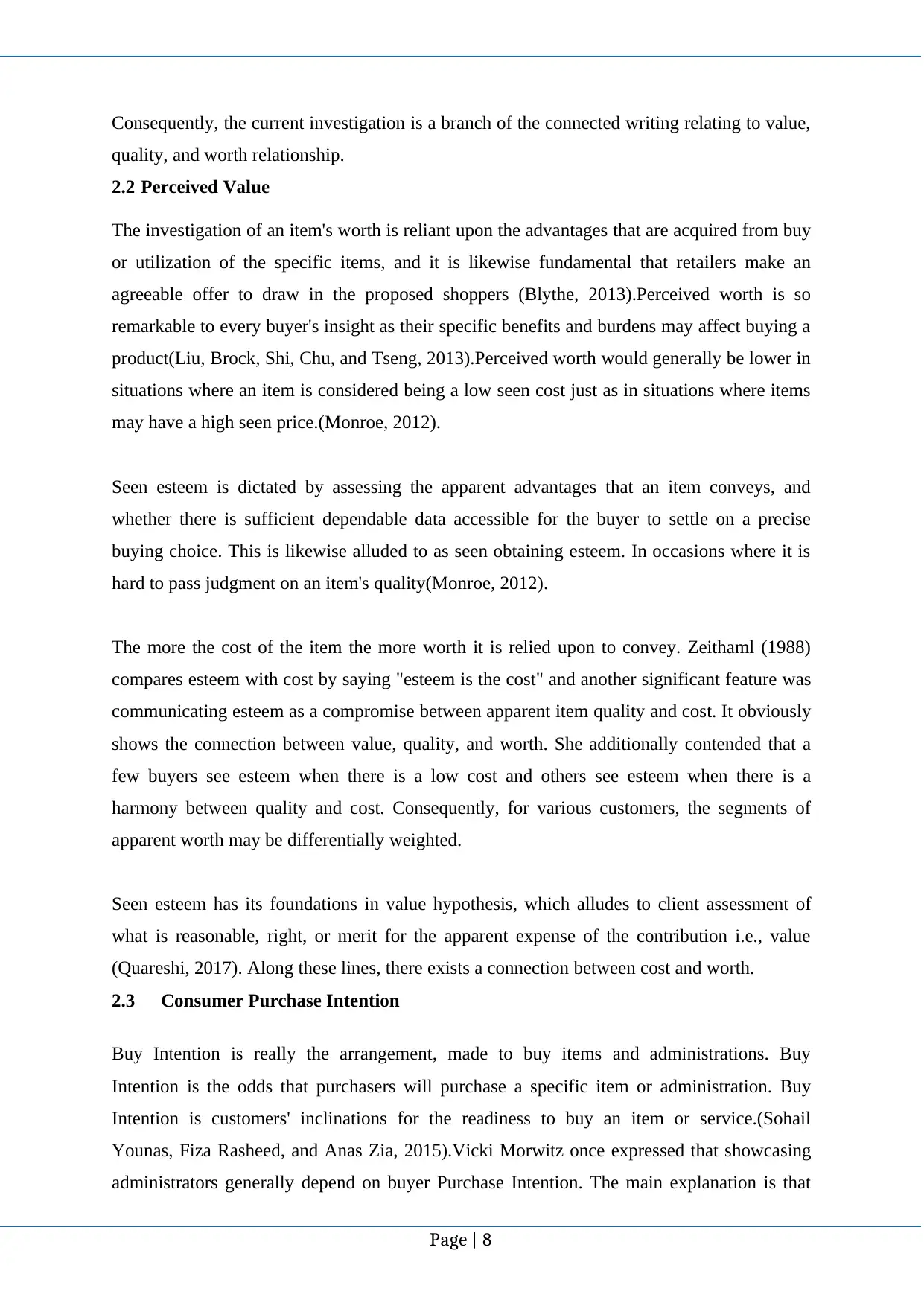
Consequently, the current investigation is a branch of the connected writing relating to value,
quality, and worth relationship.
2.2 Perceived Value
The investigation of an item's worth is reliant upon the advantages that are acquired from buy
or utilization of the specific items, and it is likewise fundamental that retailers make an
agreeable offer to draw in the proposed shoppers (Blythe, 2013).Perceived worth is so
remarkable to every buyer's insight as their specific benefits and burdens may affect buying a
product(Liu, Brock, Shi, Chu, and Tseng, 2013).Perceived worth would generally be lower in
situations where an item is considered being a low seen cost just as in situations where items
may have a high seen price.(Monroe, 2012).
Seen esteem is dictated by assessing the apparent advantages that an item conveys, and
whether there is sufficient dependable data accessible for the buyer to settle on a precise
buying choice. This is likewise alluded to as seen obtaining esteem. In occasions where it is
hard to pass judgment on an item's quality(Monroe, 2012).
The more the cost of the item the more worth it is relied upon to convey. Zeithaml (1988)
compares esteem with cost by saying "esteem is the cost" and another significant feature was
communicating esteem as a compromise between apparent item quality and cost. It obviously
shows the connection between value, quality, and worth. She additionally contended that a
few buyers see esteem when there is a low cost and others see esteem when there is a
harmony between quality and cost. Consequently, for various customers, the segments of
apparent worth may be differentially weighted.
Seen esteem has its foundations in value hypothesis, which alludes to client assessment of
what is reasonable, right, or merit for the apparent expense of the contribution i.e., value
(Quareshi, 2017). Along these lines, there exists a connection between cost and worth.
2.3 Consumer Purchase Intention
Buy Intention is really the arrangement, made to buy items and administrations. Buy
Intention is the odds that purchasers will purchase a specific item or administration. Buy
Intention is customers' inclinations for the readiness to buy an item or service.(Sohail
Younas, Fiza Rasheed, and Anas Zia, 2015).Vicki Morwitz once expressed that showcasing
administrators generally depend on buyer Purchase Intention. The main explanation is that
Page | 8
quality, and worth relationship.
2.2 Perceived Value
The investigation of an item's worth is reliant upon the advantages that are acquired from buy
or utilization of the specific items, and it is likewise fundamental that retailers make an
agreeable offer to draw in the proposed shoppers (Blythe, 2013).Perceived worth is so
remarkable to every buyer's insight as their specific benefits and burdens may affect buying a
product(Liu, Brock, Shi, Chu, and Tseng, 2013).Perceived worth would generally be lower in
situations where an item is considered being a low seen cost just as in situations where items
may have a high seen price.(Monroe, 2012).
Seen esteem is dictated by assessing the apparent advantages that an item conveys, and
whether there is sufficient dependable data accessible for the buyer to settle on a precise
buying choice. This is likewise alluded to as seen obtaining esteem. In occasions where it is
hard to pass judgment on an item's quality(Monroe, 2012).
The more the cost of the item the more worth it is relied upon to convey. Zeithaml (1988)
compares esteem with cost by saying "esteem is the cost" and another significant feature was
communicating esteem as a compromise between apparent item quality and cost. It obviously
shows the connection between value, quality, and worth. She additionally contended that a
few buyers see esteem when there is a low cost and others see esteem when there is a
harmony between quality and cost. Consequently, for various customers, the segments of
apparent worth may be differentially weighted.
Seen esteem has its foundations in value hypothesis, which alludes to client assessment of
what is reasonable, right, or merit for the apparent expense of the contribution i.e., value
(Quareshi, 2017). Along these lines, there exists a connection between cost and worth.
2.3 Consumer Purchase Intention
Buy Intention is really the arrangement, made to buy items and administrations. Buy
Intention is the odds that purchasers will purchase a specific item or administration. Buy
Intention is customers' inclinations for the readiness to buy an item or service.(Sohail
Younas, Fiza Rasheed, and Anas Zia, 2015).Vicki Morwitz once expressed that showcasing
administrators generally depend on buyer Purchase Intention. The main explanation is that
Page | 8
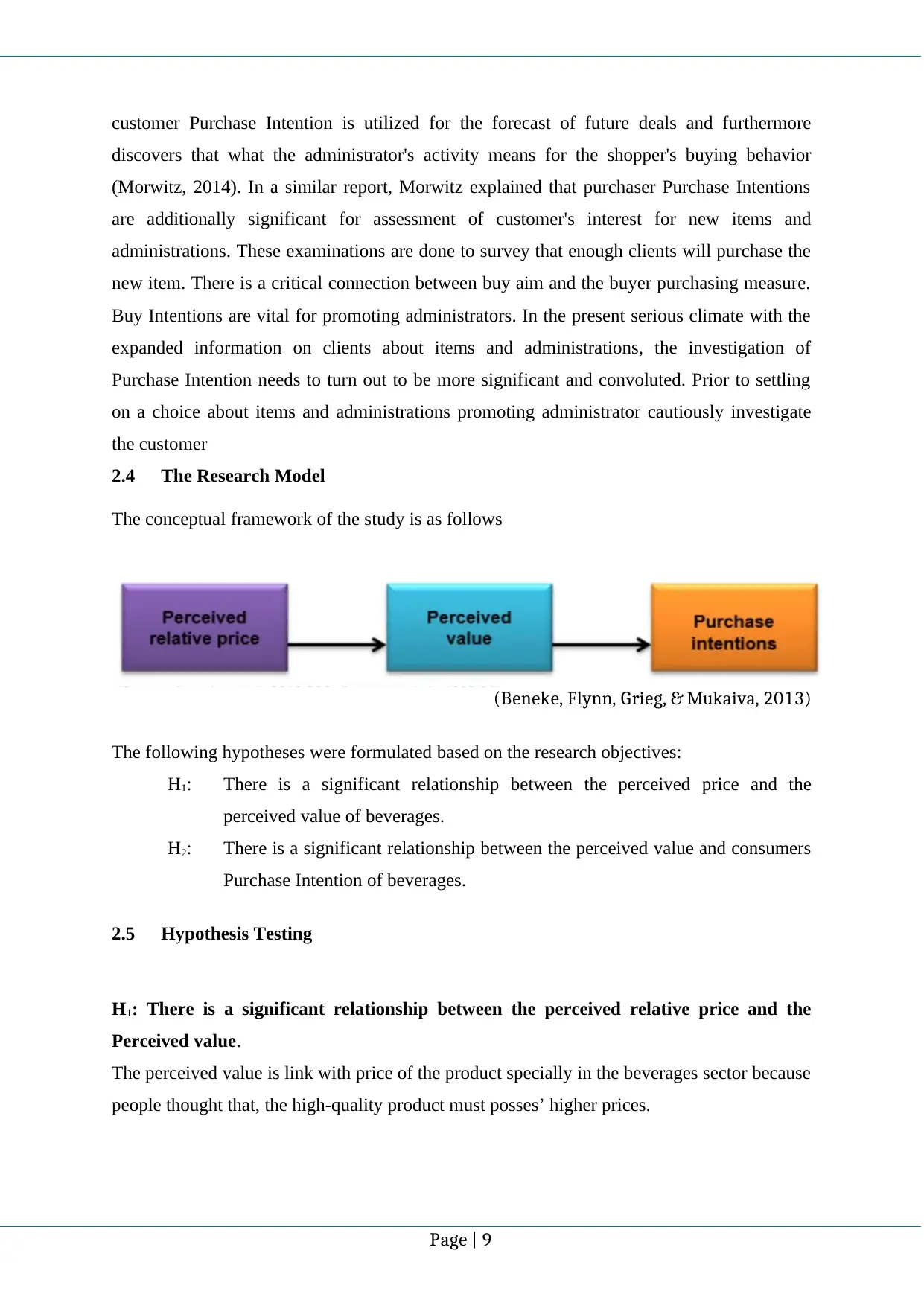
customer Purchase Intention is utilized for the forecast of future deals and furthermore
discovers that what the administrator's activity means for the shopper's buying behavior
(Morwitz, 2014). In a similar report, Morwitz explained that purchaser Purchase Intentions
are additionally significant for assessment of customer's interest for new items and
administrations. These examinations are done to survey that enough clients will purchase the
new item. There is a critical connection between buy aim and the buyer purchasing measure.
Buy Intentions are vital for promoting administrators. In the present serious climate with the
expanded information on clients about items and administrations, the investigation of
Purchase Intention needs to turn out to be more significant and convoluted. Prior to settling
on a choice about items and administrations promoting administrator cautiously investigate
the customer
2.4 The Research Model
The conceptual framework of the study is as follows
(Beneke, Flynn, Grieg, & Mukaiva, 2013)
The following hypotheses were formulated based on the research objectives:
H1: There is a significant relationship between the perceived price and the
perceived value of beverages.
H2: There is a significant relationship between the perceived value and consumers
Purchase Intention of beverages.
2.5 Hypothesis Testing
H1: There is a significant relationship between the perceived relative price and the
Perceived value.
The perceived value is link with price of the product specially in the beverages sector because
people thought that, the high-quality product must posses’ higher prices.
Page | 9
discovers that what the administrator's activity means for the shopper's buying behavior
(Morwitz, 2014). In a similar report, Morwitz explained that purchaser Purchase Intentions
are additionally significant for assessment of customer's interest for new items and
administrations. These examinations are done to survey that enough clients will purchase the
new item. There is a critical connection between buy aim and the buyer purchasing measure.
Buy Intentions are vital for promoting administrators. In the present serious climate with the
expanded information on clients about items and administrations, the investigation of
Purchase Intention needs to turn out to be more significant and convoluted. Prior to settling
on a choice about items and administrations promoting administrator cautiously investigate
the customer
2.4 The Research Model
The conceptual framework of the study is as follows
(Beneke, Flynn, Grieg, & Mukaiva, 2013)
The following hypotheses were formulated based on the research objectives:
H1: There is a significant relationship between the perceived price and the
perceived value of beverages.
H2: There is a significant relationship between the perceived value and consumers
Purchase Intention of beverages.
2.5 Hypothesis Testing
H1: There is a significant relationship between the perceived relative price and the
Perceived value.
The perceived value is link with price of the product specially in the beverages sector because
people thought that, the high-quality product must posses’ higher prices.
Page | 9
⊘ This is a preview!⊘
Do you want full access?
Subscribe today to unlock all pages.

Trusted by 1+ million students worldwide
1 out of 28
Related Documents
Your All-in-One AI-Powered Toolkit for Academic Success.
+13062052269
info@desklib.com
Available 24*7 on WhatsApp / Email
![[object Object]](/_next/static/media/star-bottom.7253800d.svg)
Unlock your academic potential
Copyright © 2020–2025 A2Z Services. All Rights Reserved. Developed and managed by ZUCOL.





